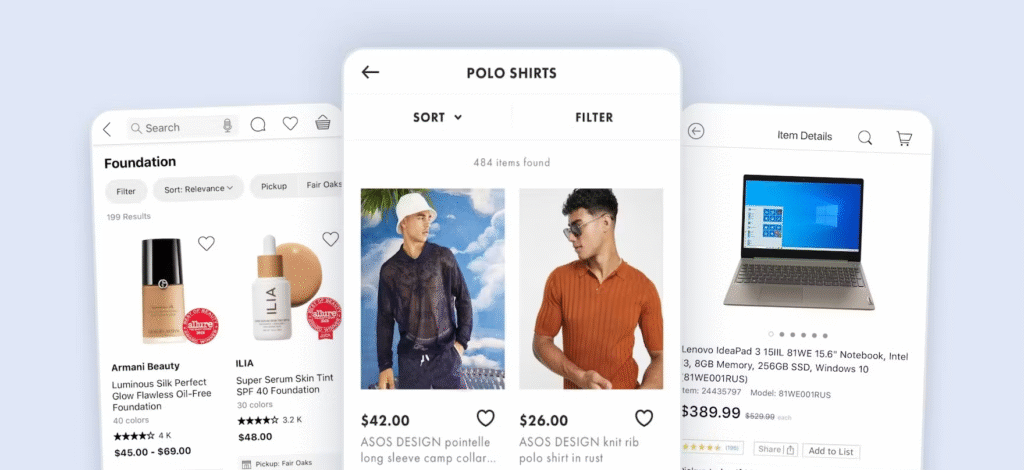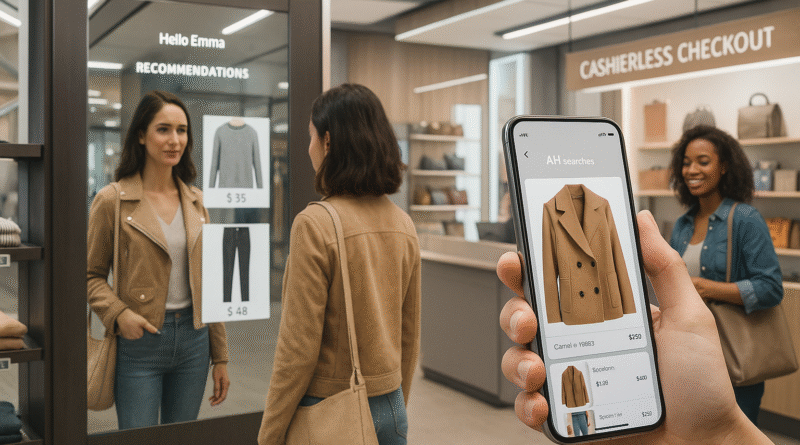Breaking Down AI in Retail: How Machines Are Changing Shopping
AI in Retail Introduction
Shopping has always evolved with technology, from the cash register to e-commerce to mobile payments. But in 2025, we’re entering a new era: where AI is not just changing shopping, it’s reshaping it entirely.
Imagine walking into a store where the shelves restock themselves, prices update based on demand, and your favorite items are waiting in a fitting room picked just for you. Or browsing online and having a virtual stylist (powered by AI, of course) recommend the perfect pair of jeans for your body shape and taste.
This isn’t sci-fi. It’s retail, supercharged by artificial intelligence.
Let’s break it down: how machines are learning your preferences, streamlining operations, and making shopping smarter (and, honestly, a little spooky in a good way).
Table of Contents
Why This Matters Now
Retail isn’t just about transactions anymore, it’s about experience. And in the digital age, customers want:
- Hyper-personalization
- Instant service
- Seamless omnichannel journeys
Meanwhile, retailers face:
- Fierce competition
- Changing consumer habits
- Rising costs
- Supply chain complexity
To survive and thrive, they’re turning to AI to:
- Anticipate demand
- Delight customers
- Reduce waste
- Maximize efficiency
Let’s explore how.
1. Personalized Recommendations: AI That Knows Your Taste
Ever wondered how Netflix knows what you want to watch next? Retail uses similar recommendation engines, driven by machine learning.
How it works:
- AI analyzes your past behavior (clicks, purchases, time on page)
- It compares that data with others who “shop like you”
- Then it serves up curated product suggestions

Example:
- Amazon’s “Customers who bought this also bought…”
- Zalando offering AI-based outfit curation
- Spotify-style product discovery for fashion, skincare, or tech gear
Result?
Less time scrolling, more “yes, this is exactly what I needed!”
2. Visual Search: Snap, Shop, Done
Let’s say you spot someone wearing a jacket you love, but you have no idea what it’s called. With AI-powered visual search, you just take a picture, upload it to a shopping app, and boom: exact or similar items instantly pop up.
Who’s doing it?
- Pinterest Lens
- Google Shopping
- ASOS and H&M apps
AI handles:
- Object recognition
- Style matching
- Inventory matching
It turns window-shopping into instant gratification, without needing the vocabulary.
3. Dynamic Pricing: AI Knows When You’re Ready to Buy
Prices in retail are no longer static. AI-powered dynamic pricing adjusts prices in real time based on:
- Supply and demand
- Time of day
- Customer location
- Competitor prices
- Even browsing behavior
Example:
- Airline tickets and ride-sharing do this constantly
- Fashion and electronics retailers now follow suit
Why it works:
AI ensures margins are maximized without scaring off customers, offering the right deal, at the right time, to the right person.
4. Inventory & Demand Forecasting: Never Out of Stock Again
There’s nothing worse than a customer clicking “add to cart” and being greeted with: “Oops, out of stock.”
AI minimizes that heartbreak.
How?
- Machine learning models forecast demand across regions, seasons, and product types
- It factors in weather, events, trends, even social media spikes
- Smart warehouses adjust stock automatically
Retailers like:
Walmart, Uniqlo, and Zara use AI to forecast demand with over 90% accuracy, keeping stores stocked and warehouses lean.
5. In-Store Experience: From Smart Mirrors to Cashierless Checkout
Physical retail is far from dead, it’s evolving.
Smart retail tech includes:
- AI-powered mirrors that let you try outfits virtually
- Cashierless checkouts (like Amazon Go) where you grab & go
- In-store analytics tracking movement patterns to optimize layouts
- Robots that greet you, answer product questions, or guide you to aisles
Why it matters:
Shoppers now expect digital-level personalization in physical spaces, too. AI bridges that gap.
6. Virtual Try-Ons: Try Before You Buy, Without Changing Clothes
Hate fitting rooms? You’re not alone.
Thanks to AR + AI, apps and smart mirrors now let you:
- Try on glasses, makeup, clothes, or shoes virtually
- Scan your body to get fit suggestions
- See how items look in different lighting or angles
Brands using this:
- Sephora (Virtual Artist)
- Nike Fit
- IKEA’s AR placement for furniture
Convenient? Yes. Pandemic-safe? Absolutely. Engaging? Addictive.
7. Chatbots & Customer Support: 24/7 Shopping Assistants
Forget waiting on hold. AI-powered chatbots now:
- Help with product discovery
- Answer common questions
- Track orders
- Upsell accessories
- Process returns
Example:
H&M’s chatbot can suggest outfits. Sephora’s can offer skincare advice. Nike’s bot can handle full checkout.
The beauty? They’re always available, never cranky, and never say “please hold.”
8. Fraud Detection & Secure Payments
AI isn’t just about the fun stuff, it’s also your silent protector.
Behind the scenes, AI:
- Detects unusual transaction patterns
- Blocks fraudulent purchases in real-time
- Verifies digital identities
- Secures mobile payment systems
- Stripe’s fraud detection tools
Retailers like Shopify, Stripe, and PayPal use AI-driven fraud detection to protect businesses and consumers alike.
9. Sustainability & Waste Reduction: AI Goes Green
Overproduction and excess inventory are massive problems in retail.
AI helps by:
- Forecasting exact quantities needed
- Suggesting materials based on sustainability scores
- Reducing returns by matching better products to buyers
Bonus:
AI tracks carbon footprints across the supply chain, helping eco-conscious brands walk the talk.
Example:
Stitch Fix uses AI to predict styles customers will actually wear, reducing wasteful returns.
10. Voice Shopping & Smart Recommendations
“Hey Alexa, order more shampoo.”
Done.
Voice commerce is growing fast, and AI is behind it. With integration into smart homes, voice assistants now:
- Suggest when you’re low on staples
- Offer discounts you might’ve missed
- Handle entire transactions hands-free
The more you interact, the smarter they get.
Soon, your fridge might say, “Hey Abdul, you’re out of oat milk. Want me to restock?”
FAQ
Q1: Is AI in retail only for big brands?
A1: Not anymore. Many AI tools are plug-and-play for small to medium businesses (SMBs), from chatbot builders to product recommendation engines.
Q2: Will AI replace human jobs in retail?
A2: It will shift them. Some repetitive roles may be automated, but new roles in AI management, experience design, and personalization are on the rise.
Q3: Is AI invading my privacy when it tracks shopping behavior?
A3: Reputable brands use anonymized, aggregated data and provide opt-out options. Always check privacy policies and permissions on apps.

Final Thoughts & CTA
AI is no longer a luxury in retail, it’s the invisible engine powering modern shopping. From hyper-personalized experiences to flawless logistics and greener practices, artificial intelligence is making retail faster, smarter, and more human.
Yes, human. Because the irony is: the more AI learns about us, the better it can help brands treat us like individuals, not just sales targets.
So next time a product ad seems suspiciously perfect, or a chatbot helps you pick the right running shoe at 2AM, just smile and say:
“Thanks, Skynet. But the friendly version.”
Want more on how AI is reshaping business, life, and your shopping cart? Stay close to aihunterguides.com, where we decode the tech that’s quietly taking over everything.

Pingback: 10 Brilliant AI Tools for Online Retailers to Boost Sales